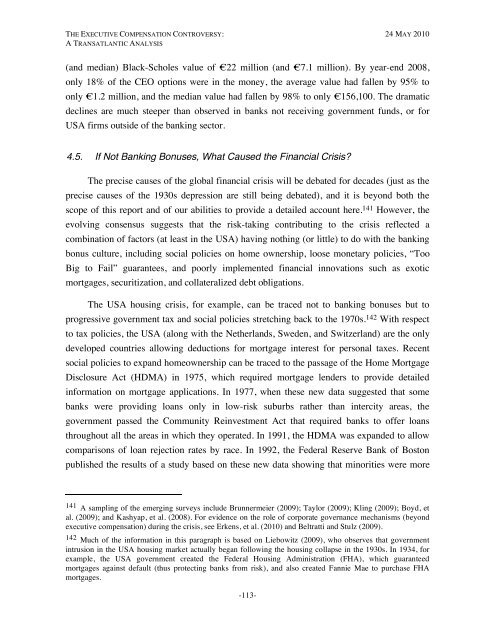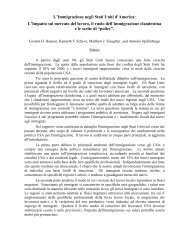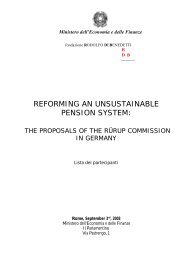The Executive Compensation Controversy - Fondazione Rodolfo ...
The Executive Compensation Controversy - Fondazione Rodolfo ...
The Executive Compensation Controversy - Fondazione Rodolfo ...
Create successful ePaper yourself
Turn your PDF publications into a flip-book with our unique Google optimized e-Paper software.
THE EXECUTIVE COMPENSATION CONTROVERSY: 24 MAY 2010A TRANSATLANTIC ANALYSIS(and median) Black-Scholes value of €22 million (and €7.1 million). By year-end 2008,only 18% of the CEO options were in the money, the average value had fallen by 95% toonly €1.2 million, and the median value had fallen by 98% to only €156,100. <strong>The</strong> dramaticdeclines are much steeper than observed in banks not receiving government funds, or forUSA firms outside of the banking sector.4.5. If Not Banking Bonuses, What Caused the Financial Crisis?<strong>The</strong> precise causes of the global financial crisis will be debated for decades (just as theprecise causes of the 1930s depression are still being debated), and it is beyond both thescope of this report and of our abilities to provide a detailed account here. 141 However, theevolving consensus suggests that the risk-taking contributing to the crisis reflected acombination of factors (at least in the USA) having nothing (or little) to do with the bankingbonus culture, including social policies on home ownership, loose monetary policies, “TooBig to Fail” guarantees, and poorly implemented financial innovations such as exoticmortgages, securitization, and collateralized debt obligations.<strong>The</strong> USA housing crisis, for example, can be traced not to banking bonuses but toprogressive government tax and social policies stretching back to the 1970s. 142 With respectto tax policies, the USA (along with the Netherlands, Sweden, and Switzerland) are the onlydeveloped countries allowing deductions for mortgage interest for personal taxes. Recentsocial policies to expand homeownership can be traced to the passage of the Home MortgageDisclosure Act (HDMA) in 1975, which required mortgage lenders to provide detailedinformation on mortgage applications. In 1977, when these new data suggested that somebanks were providing loans only in low-risk suburbs rather than intercity areas, thegovernment passed the Community Reinvestment Act that required banks to offer loansthroughout all the areas in which they operated. In 1991, the HDMA was expanded to allowcomparisons of loan rejection rates by race. In 1992, the Federal Reserve Bank of Bostonpublished the results of a study based on these new data showing that minorities were more141 A sampling of the emerging surveys include Brunnermeier (2009); Taylor (2009); Kling (2009); Boyd, etal. (2009); and Kashyap, et al. (2008). For evidence on the role of corporate governance mechanisms (beyondexecutive compensation) during the crisis, see Erkens, et al. (2010) and Beltratti and Stulz (2009).142 Much of the information in this paragraph is based on Liebowitz (2009), who observes that governmentintrusion in the USA housing market actually began following the housing collapse in the 1930s. In 1934, forexample, the USA government created the Federal Housing Administration (FHA), which guaranteedmortgages against default (thus protecting banks from risk), and also created Fannie Mae to purchase FHAmortgages.-113-









